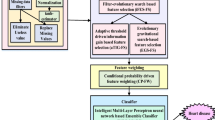Abstract
Designing drugs is a current problem in the pharmaceutical research. By designing a drug we mean to choose some variables of drug formulation (inputs), for obtaining optimal characteristics of drug (outputs). To solve such a problem we propose an ensemble of three learning algorithms namely an evolutionary artificial neural network, Takagi-Sugeno neuro-fuzzy system and an artificial neural network. The ensemble combination is optimized by a particle swarm optimization algorithm. The experimental data were obtained from the Laboratory of Pharmaceutical Techniques of the Faculty of Pharmacy in Cluj-Napoca, Romania. Bootstrap techniques were used to generate more samples of data since the number of experimental data was low due to the costs and time durations of experimentations. Experiment results indicate that the proposed methods are efficient.










Similar content being viewed by others
References
Parrill AL (1996) Evolutionary and genetic methods in drug design. Drug Discov Today 1(12):514–521
Zoubir AM, Iskander DR (1998) Bootstrap MATLAB Toolbox. Software reference manual
Abraham A (2004) Meta-learning evolutionary artificial neural networks. Neurocomp J 56c:1–38
Abraham A (2001) Neuro-fuzzy systems: state-of-the-art modeling techniques, connectionist models of neurons, learning processes, and artificial intelligence. In: Mira J, Prieto A (eds.) Lecture notes in computer science. Springer, Berlin, LNCS 2084, pp 269–276
Barat A, Ruskin HJ, Crane M (2006) Probabilistic models for drug dissolution. Part 1. Review of Monte Carlo and stochastic cellular automata approaches. Simul Model Pract Theory 14(7):843–856
Laghaee A, Malcolm C, Hallam J, Ghazal P (2005) Artificial intelligence and robotics in high throughput post-genomics. Drug Discov Today 10(18):1253–1259
Carlsson C, Fullér R (1998) Multiobjective optimization with linguistic variables. In: Proceedings of the sixth European congress on intelligent techniques and soft computing, Aachen, September 7–10, 1998, Verlag Mainz
Winkler DA, Burden FR (2004) Bayesian neural nets for modeling in drug discovery. Drug Discov Today: BIOSILICO 2(3):104–111
Aradi I, Erdi P (2006) Computational neuropharmacology: dynamical approaches in drug discovery. Trends Pharmacol Sci 27(5):240–243
Carpenter J, Goldstein H, Rasbash J (1999) A non-parametric bootstrap for multilevel models. Multilevel Model Newsl 11:2–5
Jang SR, Sun CT, Mizutani E (1997) Neuro-fuzzy and soft computing: a computational approach to learning and machine intelligence. Prentice Hall, Englewood Cliffs
DiMasi JA, Hansen RW, Grabowski HG (2003) The price of innovation: new estimates of drug development costs. J Health Econ 22:151–185
Takayama K, Fujikawa M, Obata Y, Morishita M (2003) Neural network based optimization of drug formulations. Adv Drug Deliv Rev 55(9):1217–1231
Kennedy J, Eberhart RC (1995) Particle swarm optimization. In: Proceedings of the IEEE international conference on neural networks, Vol. IV, pp 1942–1948. IEEE service center, Piscataway, NJ
Stewart KD, Shiroda M, James CA (2006) Drug Guru: a computer software program for drug design using medicinal chemistry rules. Bioorg Med Chem 14(20):7011–7022
Hu L, Chen GH, Chau RMW (2006) A neural networks-based drug discovery approach and its application for designing aldose reductase inhibitors. J Mol Graph Model 24(4):244–253
Teroth L, Gasteiger J (2001) Neural networks and genetic algorithms in drug design. Drug Discov Today 6(2):102–108
Moller AF (1993) A scaled conjugate gradient algorithm for fast supervised learning. Neural Netw 6:525–533
Meek PJ, Liu Z, Tian L, Wang CY, Welsh WJ, Zauhar RJ (2006) Shape signatures: speeding up computer aided drug discovery. Drug Discov Today 11(19–20):895–904
Esseiva P, Anglada F, Dujourdy L, Taroni F, Margot P, Pasquier ED, Dawson M, Roux C, Doble P (2005) Chemical profiling and classification of illicit heroin by principal component analysis, calculation of inter sample correlation and artificial neural networks. Talanta 67(2):360–367
Burbidge R, Trotter M, Buxton B, Holden S (2001) Drug design by machine learning: support vector machines for pharmaceutical data analysis. Comput Chem 26(1):5–14
Câmpean R, Prodan A (2003) Biomatematică – aplicaţii în Excel, Editura Medicală Universitară “Iuliu Haţieganu”, Cluj-Napoca, ISBN: 973-693-016-5
Câmpean R, Prodan A (2003) A rating model applied for designing drugs. In: Proceedings of the 12-th IASTED international conference on applied simulation and modelling, Marbella, Spain, pp 557–561, ACTA press, ISBN: 0-88986-384-9, ISSN: 1021–8181
Agatonovic-Kustrin S, Beresford R (2000) Basic concepts of artificial neural network (ANN) modeling and its application in pharmaceutical research. J Pharm Biomed Anal 22(5):717–727
Hesterberg T, Monaghan S, Moore DS, Clipson A, Epstein R (2003) Bootstrap methods and permutation tests. W. H. Freeman and Company, New York
Solmajer T, Zupan J (2004) Optimization algorithms and natural computing in drug discovery. Drug Discov Today: Technol 1(3):247–252
Kiss T, Érdi P (2006) From electric patterns to drugs: perspectives of computational neuroscience in drug design. Biosystems 86(1–3):46–52
Sun Y, Peng Y, Chen Y, Shukla AJ (2003) Application of artificial neural networks in the design of controlled release drug delivery systems. Adv Drug Deliv Rev 55(9):1201–1215
Tang Y, Zhu W, Chen K, Jiang H (2006) New technologies in computer-aided drug design: toward target identification and new chemical entity discovery. Drug Discov Today: Technol 3(3):307–313
Grosan C, Abraham A, Tigan S (2006) Engineering drug design using a multi-input multi-output neuro-fuzzy system, 8th International symposium on symbolic and numeric algorithms for scientific computing (SYNASC'06), Timisoara, Romania, IEEE CS Press, pp 365–371
Grosan C, Abraham A, Tigan S, Chang T-G, Kim DH (2006) Evolving neural networks for pharmaceutical research, International conference on hybrid information technology (ICHIT'06), IEEE Press, Korea, pp 13–19
Acknowledgments
Authors would also like to thank the colleagues of the Department of Maxillofacial Surgery, University of Medicine and Pharmacy, Iuliu Hatieganu Cluj-Napoca, for the initial contributions of this research
Author information
Authors and Affiliations
Corresponding author
Rights and permissions
About this article
Cite this article
Abraham, A., Grosan, C. & Ţigan, Ş. Ensemble of hybrid neural network learning approaches for designing pharmaceutical drugs. Neural Comput & Applic 16, 307–316 (2007). https://doi.org/10.1007/s00521-007-0090-1
Received:
Accepted:
Published:
Issue Date:
DOI: https://doi.org/10.1007/s00521-007-0090-1




